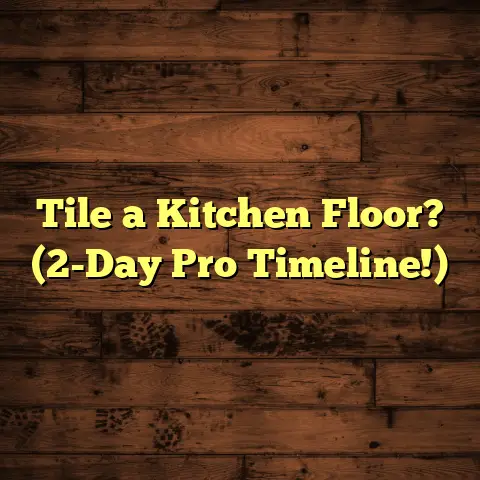Area Rugs On Hardwood: Good Idea? (5 Top Mistakes!)
(5 Top Mistakes!)
Have you ever dreamed of transforming your hardwood floors into a cozy, stylish oasis with the perfect area rug?
I’ve been a flooring contractor for over 15 years, and I’ve seen it all when it comes to area rugs on hardwood.
Some homeowners nail it, creating a stunning, comfortable space.
Others? Well, let’s just say they run into some common pitfalls that can actually damage their beautiful hardwood.
In this article, I’m going to share my expert knowledge to help you avoid those mistakes and achieve the look you’re after.
The Allure of Area Rugs on Hardwood Floors
Why do so many of us love the look of area rugs on hardwood?
I think it boils down to a few key reasons.
First, there’s the aesthetic appeal.
Hardwood floors can sometimes feel a little cold or stark.
An area rug instantly adds warmth, texture, and personality to a room.
You can use it to introduce color, pattern, and visual interest, creating a focal point or tying together your existing decor.
Think about a living room with dark hardwood floors.
A vibrant, patterned area rug can brighten the space and add a touch of bohemian flair.
Or consider a bedroom with light-colored hardwood.
A plush, neutral rug can create a cozy and inviting atmosphere.
Beyond aesthetics, area rugs also offer practical benefits.
They can significantly reduce noise levels, which is especially helpful in apartments or homes with active families.
The National Wood Flooring Association (NWFA) actually recommends using area rugs in high-traffic areas to protect your hardwood from wear and tear.
And let’s be honest, a soft rug underfoot just feels good!
The Top 5 Mistakes Homeowners Make When Using Area Rugs on Hardwood Floors
Okay, so area rugs are great.
But here’s the thing: you need to do it right.
I’ve seen so many homeowners make the same mistakes over and over again, leading to disappointment and even damage to their floors.
Let’s dive into the top 5 mistakes and how to avoid them.
Mistake #1: Choosing the Wrong Size
Size matters, folks.
I can’t stress this enough.
A rug that’s too small can make a room feel disjointed and awkward.
A rug that’s too large can overwhelm the space and make it feel smaller.
So, how do you choose the right size?
First, measure your space.
Consider the layout of your room and the placement of your furniture.
Here are a few general guidelines I use:
-
Living Room: The rug should be large enough to anchor your furniture. At least the front legs of your sofa and chairs should be on the rug. Ideally, all legs should be on the rug.
-
Dining Room: The rug should extend at least 24 inches beyond the edges of your table to allow chairs to be pulled out comfortably.
-
Bedroom: You can either place a large rug under the entire bed, or use smaller rugs on either side of the bed.
A common pitfall I see is people buying rugs that are way too small.
They end up looking like postage stamps floating in the middle of the room.
Another mistake is buying a rug that’s so large it runs right up to the walls.
You want to leave some exposed hardwood to create a sense of space and prevent the room from feeling cramped.
Example:
Let’s say you have a living room that’s 12ft x 15ft.
You have a sofa, two chairs, and a coffee table.
In this case, an 8ft x 10ft or 9ft x 12ft rug would likely be a good fit.
It would be large enough to anchor your furniture and create a defined seating area.
Mistake #2: Neglecting Rug Placement and Arrangement
Okay, you’ve got the right size rug.
Now what?
Placement is key.
The way you position your rug can significantly impact the flow and functionality of your room.
Think about how people move through the space.
You want to create a comfortable and inviting atmosphere, not an obstacle course.
Here are a few tips on arranging furniture around your rug:
-
Define Zones: Use rugs to define different areas within a larger space. For example, you could use one rug to define a seating area and another to define a reading nook.
-
Create Balance: Pay attention to the placement of your furniture. You want to create a balanced and harmonious look. Avoid placing all of your furniture on one side of the rug.
-
Consider Traffic Flow: Make sure there’s enough space for people to walk comfortably around the rug. You don’t want people tripping over the edges.
I often see people make the mistake of placing a rug in the middle of a room without considering the furniture arrangement.
The rug ends up feeling disconnected and out of place.
Another common mistake is placing a rug too close to a doorway, creating a tripping hazard.
Example:
In a dining room, center the rug under the table.
Make sure the rug is large enough so that the chairs don’t catch on the edge of the rug when pulled out.
This creates a cohesive and functional dining space.
Mistake #3: Ignoring Material and Texture Compatibility
Not all rugs are created equal.
The material and texture of your rug can significantly impact its durability, maintenance, and overall look.
And, more importantly, how it interacts with your hardwood floors.
Let’s talk about some common rug materials and their pros and cons:
-
Wool: Wool rugs are durable, soft, and naturally stain-resistant. They’re a great choice for high-traffic areas, but they can be expensive.
-
Synthetic (e.g., Nylon, Polypropylene): Synthetic rugs are affordable, stain-resistant, and easy to clean. They’re a good option for families with kids or pets, but they may not be as soft or durable as wool rugs.
-
Jute: Jute rugs are natural, textured, and relatively inexpensive. They add a rustic touch to a room, but they’re not very durable and can be difficult to clean.
-
Cotton: Cotton rugs are soft, lightweight, and easy to clean. They’re a good choice for low-traffic areas, but they can wear out quickly.
I’ve seen homeowners make the mistake of choosing a rug material that’s not compatible with their lifestyle or their hardwood floors.
For example, a delicate silk rug in a high-traffic area is a recipe for disaster.
Another common mistake is choosing a rug with a rough texture that scratches the hardwood floor.
Example:
If you have pets, a synthetic rug like polypropylene might be a good choice because it’s stain-resistant and easy to clean.
If you’re looking for a luxurious and durable rug for your living room, wool is a great option.
Pay attention to the texture of the rug.
A smooth, low-pile rug is less likely to scratch your hardwood floors than a rough, high-pile rug.
Mistake #4: Failing to Consider Maintenance and Cleaning
Let’s be honest, cleaning isn’t the most glamorous part of homeownership.
But it’s essential for maintaining the beauty and longevity of your area rugs and hardwood floors.
Ignoring maintenance can lead to a buildup of dirt, dust, and allergens, which can damage your floors and affect your health.
Here are a few tips on rug maintenance and cleaning:
-
Vacuum Regularly: Vacuum your rug at least once a week to remove dirt and debris. Use a vacuum with a beater bar for low-pile rugs and a suction-only vacuum for high-pile rugs.
-
Spot Clean Spills Immediately: Blot up spills immediately with a clean, dry cloth. Avoid rubbing, which can spread the stain.
-
Professional Cleaning: Have your rug professionally cleaned every 12-18 months to remove deep-seated dirt and stains.
A common mistake I see is people neglecting to vacuum their rugs regularly.
Dirt and debris can grind into the fibers of the rug, causing it to wear out prematurely.
Another mistake is using harsh chemicals or cleaning products that can damage the rug or the hardwood floor.
Example:
Always test cleaning products on a small, inconspicuous area of the rug before applying them to the entire surface.
Be careful when cleaning rugs on hardwood floors.
Excessive moisture can damage the wood.
Use a dry cleaning method or a low-moisture extraction method.
Mistake #5: Overlooking the Importance of Rug Padding
Rug padding: it’s the unsung hero of area rugs on hardwood floors.
I can’t tell you how many times I’ve seen homeowners skip the rug pad to save a few bucks, only to regret it later.
A rug pad is a layer of material that sits between the rug and the hardwood floor.
It provides a number of benefits:
-
Added Comfort: A rug pad adds cushioning underfoot, making your rug feel more comfortable.
-
Stability: A rug pad prevents the rug from slipping and sliding, which can be dangerous.
-
Floor Protection: A rug pad protects your hardwood floor from scratches, dents, and stains.
-
Extended Rug Life: A rug pad helps prevent wear and tear on the rug, extending its lifespan.
There are different types of rug pads available, each with its own advantages and disadvantages.
Here are a few common types:
-
Felt: Felt rug pads are dense, durable, and provide excellent cushioning. They’re a good choice for adding comfort and protecting your floors.
-
Rubber: Rubber rug pads provide excellent grip and prevent slipping. They’re a good choice for high-traffic areas.
-
Felt-Rubber Combination: These rug pads combine the cushioning of felt with the grip of rubber. They’re a good all-around choice.
I often see people make the mistake of using a cheap, flimsy rug pad that doesn’t provide adequate protection or cushioning.
Another mistake is using a rug pad that’s the wrong size or shape.
Example:
Choose a rug pad that’s slightly smaller than the rug so that it doesn’t show around the edges.
Avoid using rug pads made of PVC or other materials that can leach chemicals onto your hardwood floor.
Conclusion
Area rugs can be a fantastic addition to your hardwood floors, adding beauty, comfort, and functionality to your home.
But it’s important to avoid the common mistakes I’ve outlined in this article.
By choosing the right size, placement, material, and rug pad, and by maintaining your rugs properly, you can create a stunning and comfortable living space that you’ll enjoy for years to come.
So, take your time, do your research, and embrace the journey of creating your ideal living space.





